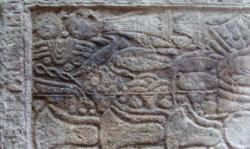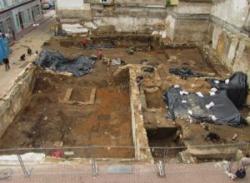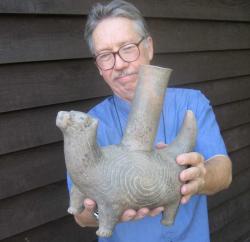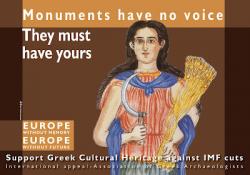INSTITUT SUPERIEUR D'ANTHROPOLOGIE
INSTITUTE OF ANTHROPOLOGY
ONLINE COURSES / COURS A DISTANCE
INSCRIPTION : Année Universitaire 2012/2013
REGISTRATION : Academic Year 2012 / 2013
EGYPTE –  Matariya - During construction work carried out by the Ministry of Endowments at the Al-Khamis market area, which is next to the archaeological site of Matariya in northern Cairo, workers stumbled upon a part of an ancient Egyptian stele. Minister of State for Antiquities Mohamed Ibrahim explained that the newly-discovered stone artefact is the right section of a New Kingdom stele, on which is displayed a complete, illustrated list of various offerings to ancient Egyptian deities. A collection of geese, vegetables, fruits, bread, and cattle is depicted. Lotus flowers are also shown, as well as religious worship poetry in hieroglyphic form. Although the cartouche of the owner or the reign when it was engraved has not yet been identified on the stele, Ibrahim said that it would reveal more of the history of this mysterious area, which includes monuments from the early pharaonic to the Ptolemaic era. Mohamed El-Beyali, head of the ancient Egyptian department at the Ministry of State for Antiquities, said that initial studies on the stele show that it can be dated to the late 18th or the beginning of the 19th dynasty. He added that Matariya is a very important archaeological site, as it was a centre for the worship of the sun god Aten and it was the capital city of north Egypt. The site includes an obelisk of Senousert I, a collection of ancient Egyptian and Ptolemaic tombs, and the remains of one of the oldest universities ever. A collection of columns from the time of Ramses II has also been found. All construction work has now been put on hold in order to excavate the area, to reveal more of its heritage.
Matariya - During construction work carried out by the Ministry of Endowments at the Al-Khamis market area, which is next to the archaeological site of Matariya in northern Cairo, workers stumbled upon a part of an ancient Egyptian stele. Minister of State for Antiquities Mohamed Ibrahim explained that the newly-discovered stone artefact is the right section of a New Kingdom stele, on which is displayed a complete, illustrated list of various offerings to ancient Egyptian deities. A collection of geese, vegetables, fruits, bread, and cattle is depicted. Lotus flowers are also shown, as well as religious worship poetry in hieroglyphic form. Although the cartouche of the owner or the reign when it was engraved has not yet been identified on the stele, Ibrahim said that it would reveal more of the history of this mysterious area, which includes monuments from the early pharaonic to the Ptolemaic era. Mohamed El-Beyali, head of the ancient Egyptian department at the Ministry of State for Antiquities, said that initial studies on the stele show that it can be dated to the late 18th or the beginning of the 19th dynasty. He added that Matariya is a very important archaeological site, as it was a centre for the worship of the sun god Aten and it was the capital city of north Egypt. The site includes an obelisk of Senousert I, a collection of ancient Egyptian and Ptolemaic tombs, and the remains of one of the oldest universities ever. A collection of columns from the time of Ramses II has also been found. All construction work has now been put on hold in order to excavate the area, to reveal more of its heritage.
http://english.ahram.org.eg/NewsContent/9/40/51983/Heritage/Ancient-Egypt/New-stone-inscription-shows-list-of-offerings-to-a.aspx
FRANCE –  Limoges - Lors des travaux de nettoyage d'une parcelle, avant la construction d'un magasin de mode et d'ameublement, rue de la Courtine à Limoges, la découverte d'os humains a été signalée au service régional de l'archéologie. Le préfet de région a décidé d'arrêter le chantier et de mettre en oeuvre une fouille d'office, en application de l'article 531-9 du Code du Patrimoine. Les recherches archéologiques se sont achevées le 24 août dernier. Face à cette découverte archéologique majeure, la conservation de ce mausolée et de ses annexes a été actée par l'aménageur et la DRAC Limousin. La totalité des sépultures a pu être fouillée (plus de 200 tombes pour près de 300 individus) ; les squelettes, les sarcophages et les tombes en brique ont tous été prélevés pour les études ultérieures. Le principe d'une modification du projet a pu être discuté au cours de plusieurs rencontres entre la DRAC, la ville de Limoges et le maître d'ouvrage. Il a été retenu un projet qui permettrait non seulement la conservation des vestiges du mausolée, mais aussi des caves, et offrirait une visibilité partielle depuis l'espace public. Dans cet aménagement, le sous sol du nouveau bâtiment sera entièrement dévolu à la conservation des vestiges et accessible aux chercheurs, et dans certaines conditions, au public. Le permis de construire initial déjà accordé sera modifié en conséquence. Le mausolée a fait l'objet le 2 août 2012 d'une décision ministérielle d'instance de classement monument historique, ce qui a pour conséquence de le mettre pendant un an sous le régime des monuments classés. Pendant ce délai, la procédure ordinaire (avis de la commission régionale du patrimoine et des sites et avis de la commission nationale des monuments historiques) sera mise en oeuvre pour un classement définitif. Les modifications de façades du nouveau bâtiment liées à la conservation des vestiges et leur future valorisation, seront soumises à l'avis conforme de l'architecte des bâtiments de France.
Limoges - Lors des travaux de nettoyage d'une parcelle, avant la construction d'un magasin de mode et d'ameublement, rue de la Courtine à Limoges, la découverte d'os humains a été signalée au service régional de l'archéologie. Le préfet de région a décidé d'arrêter le chantier et de mettre en oeuvre une fouille d'office, en application de l'article 531-9 du Code du Patrimoine. Les recherches archéologiques se sont achevées le 24 août dernier. Face à cette découverte archéologique majeure, la conservation de ce mausolée et de ses annexes a été actée par l'aménageur et la DRAC Limousin. La totalité des sépultures a pu être fouillée (plus de 200 tombes pour près de 300 individus) ; les squelettes, les sarcophages et les tombes en brique ont tous été prélevés pour les études ultérieures. Le principe d'une modification du projet a pu être discuté au cours de plusieurs rencontres entre la DRAC, la ville de Limoges et le maître d'ouvrage. Il a été retenu un projet qui permettrait non seulement la conservation des vestiges du mausolée, mais aussi des caves, et offrirait une visibilité partielle depuis l'espace public. Dans cet aménagement, le sous sol du nouveau bâtiment sera entièrement dévolu à la conservation des vestiges et accessible aux chercheurs, et dans certaines conditions, au public. Le permis de construire initial déjà accordé sera modifié en conséquence. Le mausolée a fait l'objet le 2 août 2012 d'une décision ministérielle d'instance de classement monument historique, ce qui a pour conséquence de le mettre pendant un an sous le régime des monuments classés. Pendant ce délai, la procédure ordinaire (avis de la commission régionale du patrimoine et des sites et avis de la commission nationale des monuments historiques) sera mise en oeuvre pour un classement définitif. Les modifications de façades du nouveau bâtiment liées à la conservation des vestiges et leur future valorisation, seront soumises à l'avis conforme de l'architecte des bâtiments de France.
http://www.bati-journal.com/renovation?news=50950844&actualite=chantier_de_construction_et_archeologie_preventive_un_bel_exemple_d_adaptation
USA –  St. Francis County - The clay dog looks fat and healthy. It stands squarely on sturdy legs; tail curled forward, a look of confidence on its upturned face. It's worth at least $28,000, said Dennis Arbeiter, the man who will auction it off. The dog, actually a ceramic water bottle about the size of a football with a spout shaped like a smoke stack coming straight up and out of its back, is between 600 and 1,200 years old. Found in St. Francis County, Ark., it was painstakingly crafted and decorated by a woman or a man who was a member of the prehistoric people known as Mississippians, or moundbuilders. It is considered the finest example of a dog water bottle ever found. The Mississippians are the people who built the mounds in Cahokia, including the largest known north of Mexico, Monk's Mound. Arbeiter said the dog bottle's value is in the decoration, a circle design known as "Rhodes incising," a familiar symbol to persons who visit the many known sites located on bluffs in southwestern Illinois where Mississippian wanderers carved their art into the rock. It is among a collection of exquisite Mississippian pottery and equally ancient ceramics from the closely-related Caddo people of east Texas and Arkansas that will be offered Saturday at auction at the Sangamon County Fairgrounds in New Berlin.
St. Francis County - The clay dog looks fat and healthy. It stands squarely on sturdy legs; tail curled forward, a look of confidence on its upturned face. It's worth at least $28,000, said Dennis Arbeiter, the man who will auction it off. The dog, actually a ceramic water bottle about the size of a football with a spout shaped like a smoke stack coming straight up and out of its back, is between 600 and 1,200 years old. Found in St. Francis County, Ark., it was painstakingly crafted and decorated by a woman or a man who was a member of the prehistoric people known as Mississippians, or moundbuilders. It is considered the finest example of a dog water bottle ever found. The Mississippians are the people who built the mounds in Cahokia, including the largest known north of Mexico, Monk's Mound. Arbeiter said the dog bottle's value is in the decoration, a circle design known as "Rhodes incising," a familiar symbol to persons who visit the many known sites located on bluffs in southwestern Illinois where Mississippian wanderers carved their art into the rock. It is among a collection of exquisite Mississippian pottery and equally ancient ceramics from the closely-related Caddo people of east Texas and Arkansas that will be offered Saturday at auction at the Sangamon County Fairgrounds in New Berlin.
http://www.bnd.com/2012/09/04/2309221/like-gold-dog-themed-drinking.html#storylink=rss
GRECE –  - The Association of Greek Archaeologists (SEA) launched a campaign in March this year, an international appeal for the protection of Greece’s cultural heritage and historical memory, titled Monuments Have no Voice, They Must Have Yours. Now, one of the campaign’s videos has been banned by the Central Archaeological Council. It had circulated for several months via the Internet and social media, but it failed to receive an official approval on Aug. 28 after they pointed out security lapses in guarding monuments, embarrassing authorities. The Council rejected the video because it was inspired by the grand thefts which took place at the Olympia Museum of the History of the Olympic Games in Antiquity earlier this year, when dozens of ancient artifacts were stolen, after another art theft at the Athens National Gallery, when two oil paintings by 20th-Century masters Pablo Picasso and Piet Mondrian were stolen. The Association of Greek Archaeologists put together the campaign to draw attention to funding cuts that are threatening the Greek cultural heritage and, as it said, the “austerity packages and authoritarian measures, that are currently tearing apart Greece and its monuments”.
- The Association of Greek Archaeologists (SEA) launched a campaign in March this year, an international appeal for the protection of Greece’s cultural heritage and historical memory, titled Monuments Have no Voice, They Must Have Yours. Now, one of the campaign’s videos has been banned by the Central Archaeological Council. It had circulated for several months via the Internet and social media, but it failed to receive an official approval on Aug. 28 after they pointed out security lapses in guarding monuments, embarrassing authorities. The Council rejected the video because it was inspired by the grand thefts which took place at the Olympia Museum of the History of the Olympic Games in Antiquity earlier this year, when dozens of ancient artifacts were stolen, after another art theft at the Athens National Gallery, when two oil paintings by 20th-Century masters Pablo Picasso and Piet Mondrian were stolen. The Association of Greek Archaeologists put together the campaign to draw attention to funding cuts that are threatening the Greek cultural heritage and, as it said, the “austerity packages and authoritarian measures, that are currently tearing apart Greece and its monuments”.
VIDEO = http://www.youtube.com/watch?v=LRbexQpbrbQ